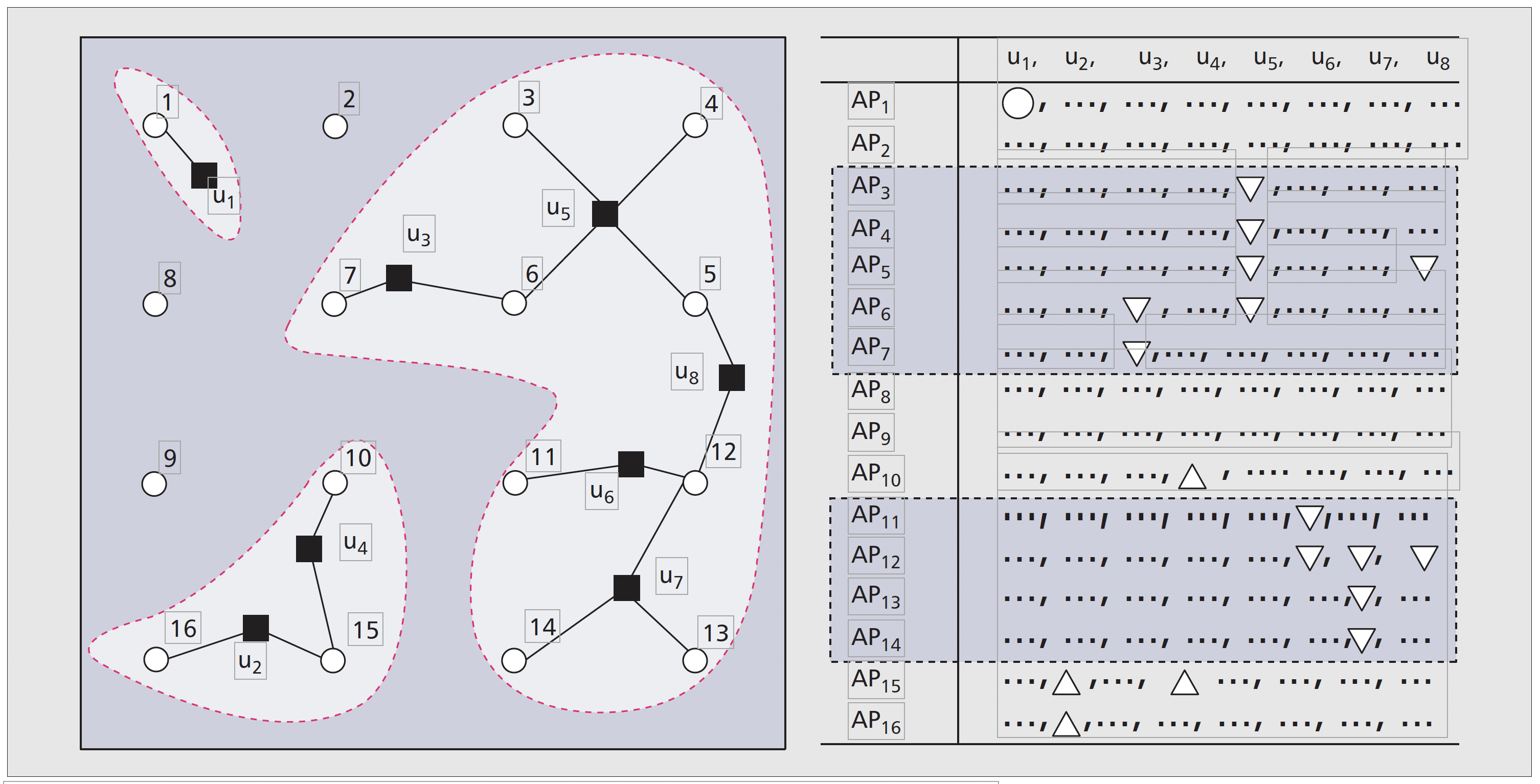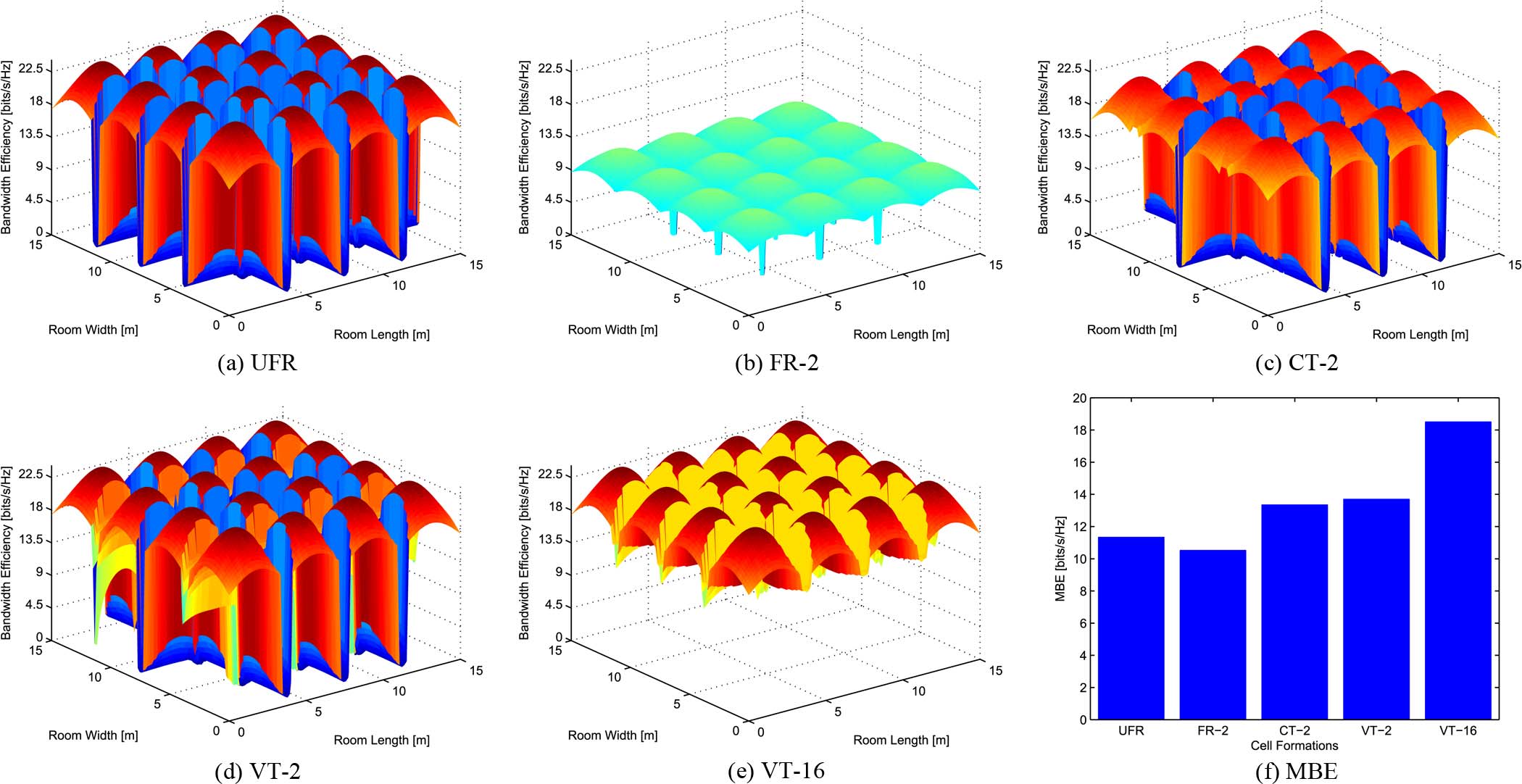You are here
Optical Wireless Communications
- User-Centric Visible Light Communication Networks
- Visible-Light-aided Heterogeneous Networks
- Physical-Layer Techniques for Visible Light and Free-Sapce Optical Communications
- Forward Error Correction Techniques in Optical Wireless and Fibre Optical Communications and their Experimental Demonstrations
- Artificial-Intelligence-Aided Optical Communications
|
User-Centric Visible Light Communication Networks |
|
As a beneficial counterpart of the existing network-centric cells, a user-centric (UC) cluster formation regime is proposed and studied in visible light communication (VLC) networks. The essence of the UC cluster formation is to assign the user equipments and optical access points to each other for the sake of maximising the total utility after employing vectored transmission (VT) in each of the UC-VT cluster. This procedure is entirely based on the user equipments' specific conditions and thus leads to UC clusters. VLC can be considered as a new member in the small-cell family of the heterogeneous networks (HetNets) landscape for complementing the overloaded radio frequency band. The UC cluster formation principle designed for VLC environments constitutes a novel and competitive design paradigm for the super dense multi-tier cell combinations of HetNets, where the sophisticated user equipments can actively participate in cell planning, resource management, mobility control, service provision, signal processing, etc. As a result, the UC concept may be expected to become one of the disruptive techniques to be used in the forthcoming 5G era.  Figure 1. Amorphous cell formation with the table of user-specific access point combinations.
Video 1. User-centric visible light communications for energy-efficient scalable video streaming. The first row shows the flawless original video, the video reconstructed by using our UC cluster formation as well as the video reconstructed by using the traditional unity frequency reuse (UFR). The second row shows the differences between the original video and the videos reconstructed by using UC/UFR. The fist sub-video in the last row shows the dynamic UC cluster formation when the UC is mobile, where the access points and the users within the cluster are denoted by filled orange circles and blue asterisks, respectively. The other two sub-videos in the last row show the peak signal-to-noise ratio (PSNR) of each frame for the moving user by using the UC and UFR scheme, respectively.
|
|
VLC-aided Heterogeneous Networks |
|
As a complementary extension of established radio frequency (RF) wireless local area networks (WLANs), VLC using commercially available light-emitting diode (LED) transmitters offers a huge data rate potential in this license-free spectral domain, whilst simultaneously satisfying energy-efficient illumination demands. Various VLC cell formations, ranging from a regular cell-layout associated with different frequency reuse (FR) patterns to merged cells by employing advanced transmission scheme are investigated. Furthermore, a hybrid down-link offering full RF-coverage by a WLAN and additionally supported by the abundant spectral resources of a VLC network is studied. Cooperative load balancing achieving proportional fairness is implemented by using both centralized and distributed resource-allocation algorithms. The performance of this hybrid RF/VLC system is analysed both in terms of its throughput and fairness in diverse cell formation scenarios. Our simulation results demonstrate that, the VLC system advocated is capable of providing a high area spectral efficiency (ASE) and our hybrid RF/VLC system achieves the highest throughput and the highest grade of fairness in most of the scenarios considered.  Figure 2. Bandwidth efficiency surface and the mean bandwidth efficiency of different VLC cell formations. (a) A regular UFR cell formation, (b) has a FR factor of two, (c) represents merged 2-access-point cells with combined transmission, (d) shows merged 2-access-point cells with VT, (e) is a merged 16-access-point cell with VT, and (f) shows the mean bandwidth efficiency of (a)–(e), where field-of-view of the receivers is 120. [top]
|
|
Physical-Layer Techniques for Visible Light and Free-Sapce Optical Communications |
|
Modulation schemes constitute one of the most important physical-layer techniques in communication systems. This is especially true when jointly considering indoor illumination requirements, since the modulated signals can be used to switch on/off the LEDs, which conveys the on-off pattern-based binary information to the receiver. Since LEDs emit incoherent light, where photons have different wavelength and phase, it is an open challenge to collect appreciable signal power in a single electromagnetic mode in a practical low-cost VLC system. Hence, often the intensity modulation direct detection (IM-DD) scheme is employed, where the transmitted signal modulates the instantaneous optical power of the LEDs. Hence, IM-DD constitutes an attractive scheme and has been widely used in VLC systems. Apart from the widely known modulation schemes, e.g. on-off keying, pulse position modulation, etc. some unique modulation techniques have also been developed for VLC systems, including colour shift keying (CSK), generalised colour modulation (GCM), optical orthogonal frequency division multiplexing (OOFDM), etc. Explicitly, the CSK scheme using multi-chip LEDs was standardised in the IEEE 802.15.7 recommendation, which may be a potential modulation scheme for future VLC systems, although it relies on sophisticated implementation. An uncoded M-CSK scheme was investigated relying on a joint maximum likelihood hard-detection based VLC system, where both simulation-based and analytical bit-error-rate results were derived. By contrast, a colour-independent GCM scheme was proposed, which had the advantages of flicker-free operation, accurate dimming control and the ability to function independently of the number of LEDs at the transmitter or the photodetectors at the receiver. Moreover, there are three popular types of OOFDM proposed for VLC systems, i.e. asymmetrically clipped OOFDM (ACO-OFDM), direct current biased OOFDM (DCO-OFDM) as well as unipolar OFDM (U-OFDM). Optical Orthogonal Frequency-Division Multiplexing (O-OFDM) is eminently suitable for mitigating the multi-path and chromatic dispersion in both Visible Light Communications (VLC) and Optical Fiber Communications. We commence our discourse by surveying the conception and historic evolution of O-OFDM designed for both VLC and optical fiber, culminating in the birth of its most flexible design alternative, namely Layered Asymmetrically Clipped Optical OFDM (LACO-OFDM). We demonstrate that it is eminently suitable for intensity-modulation and direct-detection aided optical communication systems and characterize its design flexibility. It is also shown that given its flexibility, it subsumes a wide range of optical OFDM schemes conceived over the past two decades or so. The LACO-OFDM transmitter and receiver designs strike a compelling compromise between the features of the popular Asymmetrically Clipped Optical OFDM (ACO-OFDM) and Direct Current Offset OFDM (DCO-OFDM). The pivotal role of forward error correction (FEC) designs is also surveyed with the objective of striking a coding gain versus complexity trade-off. We conclude by highlighting a suite of promising techniques capable of further improving the system performance, but require further research. The take-away message of the paper crystallized in the associated design guidelines.
Figure 3. Example of the time domain representations of a LACO-OFDM signal and its 3 constituent layers for K=32 subcarriers in the frequency domain. |
|
Forward Error Correction Techniques in Optical Wireless and Fibre Optical Communications and their Experimental Demonstrations |
|
Multi-class channel coded layered asymmetrically clipped optical orthogonal frequency-division multiplexing (LACO-OFDM) is proposed, where the achievable rate of the system is derived based on our mutual information analysis. We conceive a multi-class channel encoding scheme integrated with the layered transmitter. At the receiver, both the coded and uncoded likelihood ratios are extracted for inter-layer interference cancellation and symbol detection, respectively. Simulations are conducted, and the results show that our design approaches the achievable rate within 1.1 dB for 16-QAM four layer LACO-OFDM with the aid of a half-rate eight-iteration turbo code at BER = 10-3 , outperforming its conventional counterpart by about 3.6 dB. We also conceive a multilayered coding scheme for the LACO-OFDM system, which exploits its layered structure for protecting the information bits transmitted in the base layer. Explicitly, we intrinsically integrate error correction into the layered structure of the LACO-OFDM system and invoke soft iterative decoding between the layers at the receiver. Our system operates within 2 dB of the capacity limit at a bit error ratio of 10-4 .
We conceive and characterize the first experimental demonstration of a LACO-OFDM link relying on sophisticated adaptive bit-loading. The transmission scheme can be adopted for the development of low-cost high speed unrepeatered optical connections. Unrepeatered and uncompensated transmission tests over single mode fiber (0-20 km) are reported, achieving transmission rates up to 72 Gb/s. Moreover, we characterize both uncoded and channel coded waveforms, using a multi-class coding scheme, which has specifically been developed to benefit from the layered structure of LACO-OFDM.
Fiber-wireless-Fiber links require alignment between the transmitter and receiver to a high degree of precision (typically 0.01 for a link of a few meters), and channel coding can be used for mitigating the link margin reduction caused by the limited precision of the beam-steering and tracking system. This paper reports results from an experimental study of the misalignment tolerance attained by channel coding. Explicitly, the received power penalties imposed by misalignment are characterized, and then forward error correction techniques are adopted for mitigating the performance degradation inflicted, which is quantified experimentally. Our results characterize trade-offs between coding rate, decoding complexity and the degree of misalignment. Overall, an improvement of the tolerance to misalignment up to 50% was attained for coded links compared with the uncoded counterpart. Figure 4. Throughput versus SNR of each layer of a 2-layer LACO-OFDM over a 10-km optical fiber channel.
|
|
Artificial-Intelligence-Aided Optical Communications |
|
Deep learning-aided optical orthogonal frequency division multiplexing (O-OFDM) is proposed for intensity modulated direct detection transmissions, which is termed as OOFDMNet. In particular, O-OFDMNet employs deep neural networks (DNNs) for converting a complex-valued signal into a non-negative signal in the time-domain at the transmitter and vice versa at the receiver. The associated frequency-domain signal processing remains the same as in conventional radio frequency (RF) OFDM. As a result, our scheme achieves the same spectral efficiency as the RF scheme, which has never been attained by the existing O-OFDM schemes, because they have relied on the Hermitian symmetry of the spectral-domain signal to guarantee that the time-domain signal becomes real-valued. We show that O-OFDMNet can be viewed as an autoencoder architecture, which can be trained in an end-to-end manner in order to simultaneously improve both the bit error ratio (BER) and the peak-to-average power ratio (PAPR) for transmission over both additive white Gaussian noise and frequency-selective channels. Furthermore, we intrinsically integrate a soft-decision aided channel decoder with our O-OFDMNet and investigate its coded performance relying on both convolutional and polar codes. The simulation results show that our scheme improves both the uncoded and coded BER as well as a reducing the PAPR compared to the benchmarks at the cost of a moderate additional DNN complexity. Furthermore, our scheme is capable of approaching the throughput of RF-OFDM, which is notably higher than that of conventional O-OFDM. Finally, our complexity analysis shows that O-OFDMNet is suitable for real-time operation. [top] |
